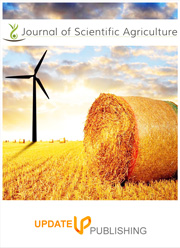Studies on in vitro response to callus induction and gene transfer technique of five high yielding indica rice varieties.
DOI:
https://doi.org/10.25081/jsa.2019.v3.5465Keywords:
Callus induction, Agrobacterium mediated gene transfer, embryogenic callus, 2,4-D.Abstract
Due to growing population, there is an increasing demand of rice production but the productivity of rice is lessened day by day. To overcome this problem various biotechnological tools can be used for developing various rice varieties. However, the lack of a simple and efficient protocol for callus induction, embryogenic callus formation and quick plant regeneration in this cereal crop. In this study embryogenic calli from mature seeds of five indica rice varieties viz. Binadhan-5, Binadhan-6, BRRI dhan-48, BRRI dhan-58 and IR-64were observed that is done in four different concentration of growth regulators (2,4-D). The highest callus induction were observed in media containing 2 mg/L 2,4-D. Among those varieties BRRI dhan-48 showed highest rate of callus induction. In this experiment Agrobacterium mediated gene transfer is also tried although plants were found nut need to be tested by molecular methods and tested the desired characters for selecting those plantlets as transgenic plant. This study will be useful for selecting suitable callus induction medium for callus induction in future.
Downloads
References
[2]. Alam MJ, Imran M, Hassan L, Rubel MH, Shamsuddoha M. In vitro regeneration of high yielding indica rice (Oryza sativa L.) varieties. Journal of Environmental Science and Natural Resources. 2012;5:173-177.
[3]. Amer AM, Mohamed GM, Hussein MH, Sedik MZ, Aly, UI. Effect of some of the natural organic sources on rice tissue culture. Egyptian Pharmaceutical Journal. 2017;16:152.
[4]. Azizi P, Rafii MY, Mahmood M, Hanafi MM, Abdullah SNA, Abiri R, Sahebi M. Highly efficient protocol for callogenesis, somagenesis and regeneration of Indica rice plants. Comptes rendus biologies. 2015;338:463-470.
[5]. Azmi M, Azlan S, Yim KM, George TV, Chew SE. Control of weedy rice in direct-seeded rice using the Clearfield production system in Malaysia. Pak J Weed Sci Res. 2012;18:49-53.
[6]. Binte Mostafiz S, Wagiran A. Efficient Callus Induction and Regeneration in Selected Indica Rice. Agronomy. 2018;8:77.
[7]. Bzour MI, Zuki FM, Mispan MS. Introduction of imidazolinone herbicide and Clearfield® rice between weedy rice—Control efficiency and environmental concerns. Environmental Reviews. 2018;26:181-198.
[8]. Dong JJ, Kharb P, Teng WM, Hall TC. Characterization of rice transformed via an Agrobacterium-mediated approach. Mol. Breed. 2001;7:187-194.
[9]. Hadiarto T, Tran LSP. Progress studies of drought-responsive genes in rice. Plant cell reports. 2011;30:297-310.
[10]. Hiei Y, Komari T. Improved protocols for transformation of indica rice mediated by Agrobacterium tumefaciens. Plant Cell Tiss. Org. Cult. 2006; 85:271-283.
[11]. Hiei Y, Komari T. Agrobacterium-mediated transformation of rice using immature embryos or calli induced from mature seed. Nature Protocols. 2008;3:824.
[12]. Hiei Y, Ohta S, Komari T, Kumashiro T. Efficient transformation of rice (Oryza sativa L.) mediated by Agrobacterium and sequence analysis of the boundaries of the T?DNA. The Plant Journal. 1994;6:271-282.
[13]. Khush GS, Virk PS. Rice breeding: achievements and future strategies. Crop improvement. 2000;27:115-144.
[14]. Khush GS, Virk PS. Rice Breeding: Achievement and future strategies. Crop Improvement. 2001;27:115-144.
[15]. Libin A, King PJH, Ong KH, Chubo JK, Sipen P. Callus induction and plant regeneration of Sarawak rice (Oryza sativa L.) variety Biris. Afr. J. Agric. Res. 2012;7:4260-4265.
[16]. Mannan MA, Sarker TC, Akter MT, Kabir AH, Alam, MF. Indirect plant regeneration in aromatic rice (Oryza sativa L.) var. ‘Kalijira’and ‘Chinigura. Acta. Agric. Slovenica. 2013; 101:231.
[17]. Pazuki A, Sohani MM. Phenotypic evaluation of scutellum-derived calluses in ‘Indica’rice cultivars. Acta agriculturae Slovenica. 2013;101:239-47.
[18]. Roly ZY, Islam MM, Shaekh MPE, Arman MSI, Shahik SM, Das D, Haamem MME, Khalekuzzaman M. In vitro callus induction and regeneration potentiality of aromatic rice cultivers (Oryza sativa L.) in differential growth regulators. Int. J. Applied Sci. & Biot. 2014;2:160-167.
[19]. Sasaki T. Rice genome analysis to understand the rice plant as an assembly of genetic codes. Photosynthesis research. 2001;70;119-127.
[20]. Sripriya R, Parameswari C, Veluthambi K. Enhancement of sheath blight tolerance in transgenic rice by combined expression of tobacco osmotin (ap24) and rice chitinase (chi11) genes. In Vitro Cellular & Developmental Biology-Plant. 2017;53:12-21.
[21]. Taylor NJ, Fauquet CM. Microparticle bombardment as a tool in plant science and agricultural biotechnology. DNA cell Biol. 2002;21:963-977
[22]. Tie W, Zhou F, Wang L, Xie W, Chen H, Li X, Lin Y. Reasons for lower transformation efficiency in indica rice using Agrobacterium tumefaciens-mediated transformation: lessons from transformation assays and genome-wide expression profiling. Plant molecular biology. 2012;78:1-18.
[23]. Tyagi AK, Mohanty A, Bajaj S, Chaudhury A, Maheshwari SC. Transgenic rice: A valuable monocot system for crop improvement and gene research. Critical Rev. Biotechnol. 1999;19:41-79.
[24]. Vaughan DA, Morishima H, Kadowaki K. Diversity in the Oryza genus. Current opinion in plant biology. 2003;6:139-146.
[25]. Verma D, Joshi R, Shukla A, Kumar P. Protocol for in vitro somatic embryogenesis and regeneration of rice (Oryza sativa L.). 2011.
[26]. Walden R, Wingender R. Gene-transfer and plant-regeneration (techniques). Trends in biotechnology. 1995;13:324-331.
[27]. YaqoobP U, JanP B, KaulP T, NawchooP IA. Tissue culture of rice: Problems, progress and prospects. IJISET. 2016;3:581-613.
[28]. Zulkarnain WM, Ismail MR, Saud HM, Othman R, Habib SH, Kausar H. Growth and yield response to water availability at different growth stages of rice. Journal of Food, Agriculture & Environment. 2013;11:540-544.



 .
.